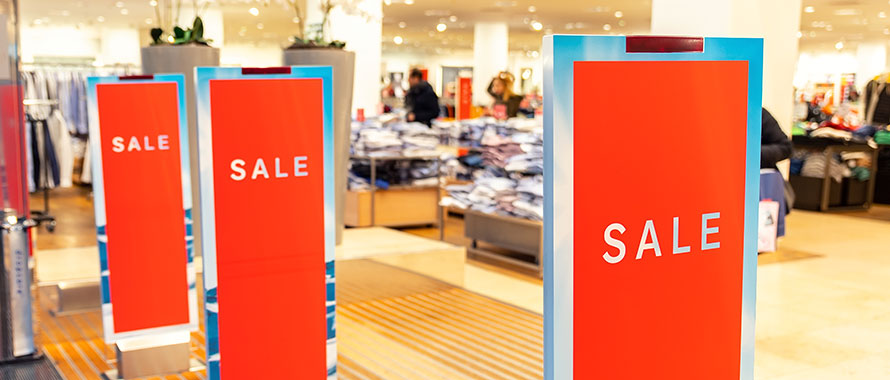Theft is a growing concern for many small business owners, according to recent data from the U.S. Chamber of Commerce. In a survey of small retailers, 56% reported experiencing theft from their stores in the past year, and half of the respondents said the issue is getting worse, the association reported. About 53% of small retailers expected even more theft to occur during the holiday season, and 43% of business owners said they have had to increase their prices in the past 12 months due to shoplifting.
Some large retailers have also reported heightened theft concerns in recent months. During an earnings call in November, a Target executive reportedly blamed “organized retail crime” in part for $400 million in extra profit losses during 2022 due to inventory shrinkage. In September, leaders at drugstore chain Rite-Aid pointed to increased shoplifting in New York City and other urban areas as part of why it faced a $5 million year-over-year rise in “shrink,” or losses due to issues like theft and fraud.
Featured Solutions
Retail shrink accounted for almost $100 billion in losses in 2021, a year during which retailers saw organized retail crime incidents go up by 26.5%, Forbes recently reported. The trend could serve as a reminder for business owners to review their Commercial Property Insurance, which can cover some types of retail theft, said Andrew Chen, Senior Broker, Commercial Insurance, Burns & Wilcox, San Francisco, California.
“Theft can be a big source of loss, especially for the smaller retailers that do not have the capacity to deal with that,” Chen said. “Having insurance coverage in place is very crucial for them.”

Theft can be a big source of loss, especially for the smaller retailers that do not have the capacity to deal with that. Having insurance coverage in place is very crucial for them.
Thefts may increase as buying power declines
In the U.S., the average loss per shoplifting incident reached about $460 in 2020, which was up almost $200 compared to 2019 but still lower than the almost $799 average shoplifting loss in 2016, Statista reported in September. In Canada, shoplifting cases involving $5,000 or less increased 3% in 2021 but remained 33% lower than the rates seen in 2019, according to crime data reported in August by Statistics Canada.
While Suda said she is not aware of an increase in theft-related insurance claims, this could be the case in some areas and official data for the year remains to be seen. However, it is a pressing concern for many business owners, especially amid discussion over a possible U.S. recession, she said. On Nov. 21, Reuters reported that investment banks expect global economic growth to continue slowing down into 2023.
“The economy is huge when it comes to influencing whether theft is up or down. There has been a lot of social unrest in the last couple of years, which is another contributor,” Suda said. “Due to the times that we are living in and buying power being significantly down, that can definitely manifest into theft claims. A lot of economists right now say it is only going to get worse before it gets better.”
In California, a retail crime task force is planning increased patrols at shopping centers in advance of the holiday shopping season, the governor’s office announced Nov. 15. Similar efforts were implemented in late 2021 after the San Francisco Bay area saw a string of mass thefts at luxury retail stores, the Guardian reported last year.
“Here in San Francisco, especially last year during the holiday season, there were a lot of organized retail crimes,” Chen noted. “It was the luxury stores, but also the Targets and Walgreens getting hit as well.”
While larger retailers may be more commonly targeted, small local retailers can be particularly vulnerable when theft occurs, Suda added. “Larger companies usually have more capital to be able to continue on, but the larger chains are at greater risk,” she said. “Then again, theft is often a crime of opportunity, and a small business without cameras or alarms could be a target.”
Mysterious disappearance not usually covered by insurance
In the event of a retail theft incident, Commercial Property Insurance can help pay for repairing physical damage to the property caused by the break-in — such as broken glass in windows or doors — and replacing stolen goods. It can also cover loss of business income when a retailer needs to shut down during repairs. “If they had business income coverage, that could pay them out for any delays or lost income,” Chen explained.
Business interruption coverage, which may not be included on all policies, can also help retailers pay their employees while they are closed. “It can replenish them during their downtime,” Suda added. “If they are a tenant in the building, it can also pay their rent that is due while they are down. It can continue to pay until the loss has been resolved. If a retailer has not purchased enough business income coverage and they are down for longer than expected, they may not be able to pay those expenses.”

If a retailer has not purchased enough business income coverage and they are down for longer than expected, they may not be able to pay those expenses.
Businesses “are constantly underbuying” this type of coverage, she pointed out. “Depending on what the commodities are and how long it takes to repair their damage, retailers generally are not buying high enough business income limits to be able to pay them for that downtime.”
However, business owners should know that theft coverage under Commercial Property Insurance will usually only be available when there is proof of the theft. Cases of mysterious disappearance are usually excluded, Chen said. “Loss of inventory would not typically be covered,” he said. “There needs to be some evidence that they were broken into versus they were just doing inventory and they notice missing stock. That is kind of like the cost of doing business. Insurance companies are not looking to cover that.”
Employee theft may also be excluded under Commercial Property Insurance. With these potential exclusions in mind, it is important for retail business owners to work with their insurance broker to understand their coverage and any add-ons that may be needed, he said.

Loss of inventory would not typically be covered. There needs to be some evidence that they were broken into versus they were just doing inventory and they notice missing stock.
Central station alarms often a prerequisite for insurance
In April, police responded to a Louis Vuitton store in Kenwood, Ohio, after a group of eight to 10 individuals entered the store and ran out with more than $100,000 in stolen merchandise, the Cincinnati Enquirer reported. In March, York Regional Police in Ontario, Canada, arrested and charged three individuals after a string of luxury retail thefts involving over $215,000 in merchandise, the Markham Economist & Sun reported. From luxury brands to electronics stores, retailers should carefully consider their business personal property limits, Chen and Suda agreed.
“Business personal property coverage can pay to actually replace the items stolen,” Suda said, so certain retailers will need to carry higher limits or could have sublimits within their policy. “Commercial Property Insurance is not a one-size-fits-all policy.”
If business owners do not accurately value their contents, they could face an underinsured loss, Chen added. “Often there will be a co-insurance clause,” he said. “If they undervalue their contents, they will get a penalty at claim time.”
While insurance carriers will each have their own requirements for policyholders, a common prerequisite for theft coverage under Commercial Property Insurance is a central station alarm system, Suda said. “This varies greatly from company to company, but many companies are going to require an alarm of sorts in order to even provide theft coverage,” she said, pointing out that coverage may be negated if the alarm was not being used at the time of the theft. “We have seen it happen where somebody forgets to put the alarm on and that is when the claim occurs, and there is no coverage.”
Retailers should aim to create “the least friendly environment” for their store to be targeted, Chen added. “These thefts are often opportunistic,” he said.
From alarm systems to after-hours security services, any steps businesses can take to reduce the risk of theft can not only help prevent a loss but could also make insurance more affordable. “The more precautions they can take, the better,” Suda said. “If they report that to their insurance company, they can sometimes get higher limits or a discount on their rates because they are being proactive to deter theft as much as they can.”






